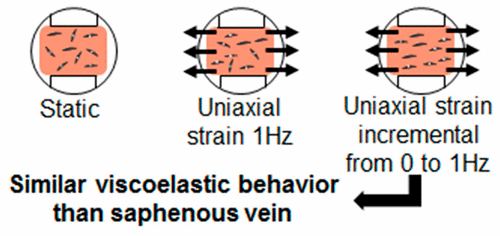当前位置:
X-MOL 学术
›
ACS Biomater. Sci. Eng.
›
论文详情
Our official English website, www.x-mol.net, welcomes your
feedback! (Note: you will need to create a separate account there.)
Incrementing the Frequency of Dynamic Strain on SMC-Cellularised Collagen-Based Scaffolds Affects Extracellular Matrix Remodeling and Mechanical Properties
ACS Biomaterials Science & Engineering ( IF 5.4 ) Pub Date : 2017-09-22 00:00:00 , DOI: 10.1021/acsbiomaterials.7b00395 L. Lévesque 1 , C. Loy 1 , A. Lainé 1 , B. Drouin 1 , P. Chevallier 1 , D. Mantovani 1
ACS Biomaterials Science & Engineering ( IF 5.4 ) Pub Date : 2017-09-22 00:00:00 , DOI: 10.1021/acsbiomaterials.7b00395 L. Lévesque 1 , C. Loy 1 , A. Lainé 1 , B. Drouin 1 , P. Chevallier 1 , D. Mantovani 1
Affiliation

|
Notwithstanding the efforts injected in vascular tissue engineering in the past 30 years, the clinical translation of engineered artery constructs is far from being successful. One common approach to improve artery regeneration is the use of cyclic mechanical stimuli to guide cellular remodeling. However, there is a lack of information on the effect of cyclic strain on cells within a 3D environment. To this end, this work explored the effect of gradual increase in stimulation frequency on the response of human umbilical artery smooth muscle cells (HUASMCs) embedded in a 3D collagen matrix. The results demonstrate that, with an applied strain of 5%, the gradual increase of frequency from 0.1 to 1 Hz improved collagen remodeling by HUASMCs compared to samples constantly stimulated at 1 Hz. The expression of collagen, elastin and matrix metalloproteinase-2 (MMP-2) genes was similar at 7 days for gradual and 1 Hz samples which showed lower amounts than static counterparts. Interestingly the mechanical properties of the constructs, specifically the amplitude of the time constants and the elastic equilibrium modulus, were enhanced by gradual increase of frequency. Taken together, these results show an increase in collagen remodeling by the HUASMCs overtime under incremental cyclic mechanical strain. This work suggests that only the in-depth investigation of the effects of stimulation parameters on the behavior of vSMC under cyclic strain in a 3D environment could lead to the design of optimized control strategies for enhanced vascular tissue generation and maturation in bioreactors.
中文翻译:

增加SMC细胞化胶原基支架上动态应变的频率会影响细胞外基质的重塑和力学性能
尽管在过去的30年中在血管组织工程中做出了努力,但工程动脉构造的临床翻译远未取得成功。改善动脉再生的一种常用方法是使用循环机械刺激来指导细胞重塑。但是,缺乏有关循环应变对3D环境中的细胞的影响的信息。为此,这项工作探索了逐渐增加刺激频率对嵌入3D胶原蛋白基质中的人脐动脉平滑肌细胞(HUASMC)反应的影响。结果表明,与在1 Hz下持续刺激的样品相比,在施加5%应变的情况下,频率从0.1 Hz逐渐增加至1 Hz改善了HUASMCs的胶原重塑。胶原蛋白的表达 弹性蛋白和基质金属蛋白酶2(MMP-2)基因在第7天的渐进和1 Hz样本中相似,显示量低于静态对应物。有趣的是,结构的机械性能,特别是时间常数的幅度和弹性平衡模量,随着频率的逐渐增加而增强。综上所述,这些结果表明,在递增的循环机械应变下,HUASMCs随着时间的推移,胶原蛋白重塑的增加。这项工作表明,只有在3D环境中循环参数下对刺激参数对vSMC行为的影响进行深入研究,才能设计出优化的控制策略,以增强生物反应器中血管组织的生成和成熟。
更新日期:2017-09-23
中文翻译:

增加SMC细胞化胶原基支架上动态应变的频率会影响细胞外基质的重塑和力学性能
尽管在过去的30年中在血管组织工程中做出了努力,但工程动脉构造的临床翻译远未取得成功。改善动脉再生的一种常用方法是使用循环机械刺激来指导细胞重塑。但是,缺乏有关循环应变对3D环境中的细胞的影响的信息。为此,这项工作探索了逐渐增加刺激频率对嵌入3D胶原蛋白基质中的人脐动脉平滑肌细胞(HUASMC)反应的影响。结果表明,与在1 Hz下持续刺激的样品相比,在施加5%应变的情况下,频率从0.1 Hz逐渐增加至1 Hz改善了HUASMCs的胶原重塑。胶原蛋白的表达 弹性蛋白和基质金属蛋白酶2(MMP-2)基因在第7天的渐进和1 Hz样本中相似,显示量低于静态对应物。有趣的是,结构的机械性能,特别是时间常数的幅度和弹性平衡模量,随着频率的逐渐增加而增强。综上所述,这些结果表明,在递增的循环机械应变下,HUASMCs随着时间的推移,胶原蛋白重塑的增加。这项工作表明,只有在3D环境中循环参数下对刺激参数对vSMC行为的影响进行深入研究,才能设计出优化的控制策略,以增强生物反应器中血管组织的生成和成熟。











































 京公网安备 11010802027423号
京公网安备 11010802027423号